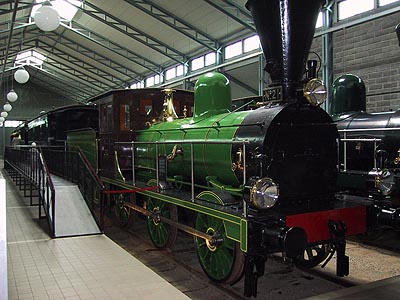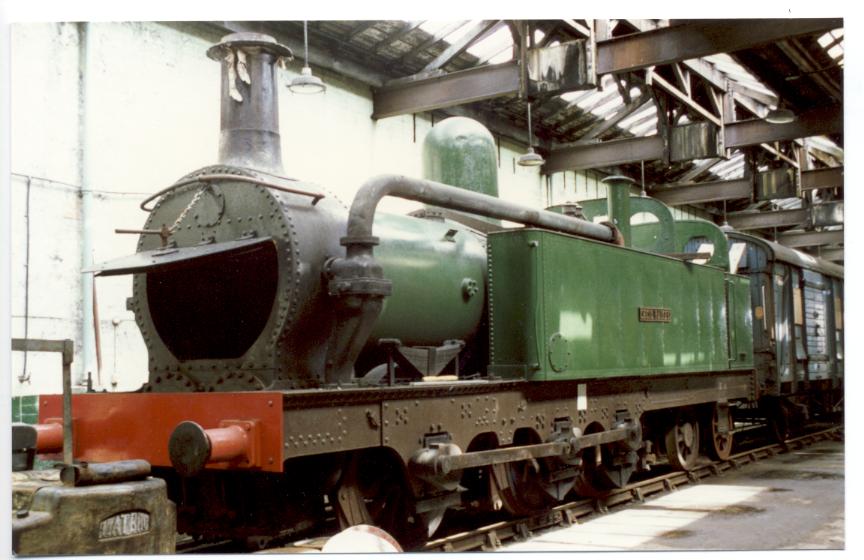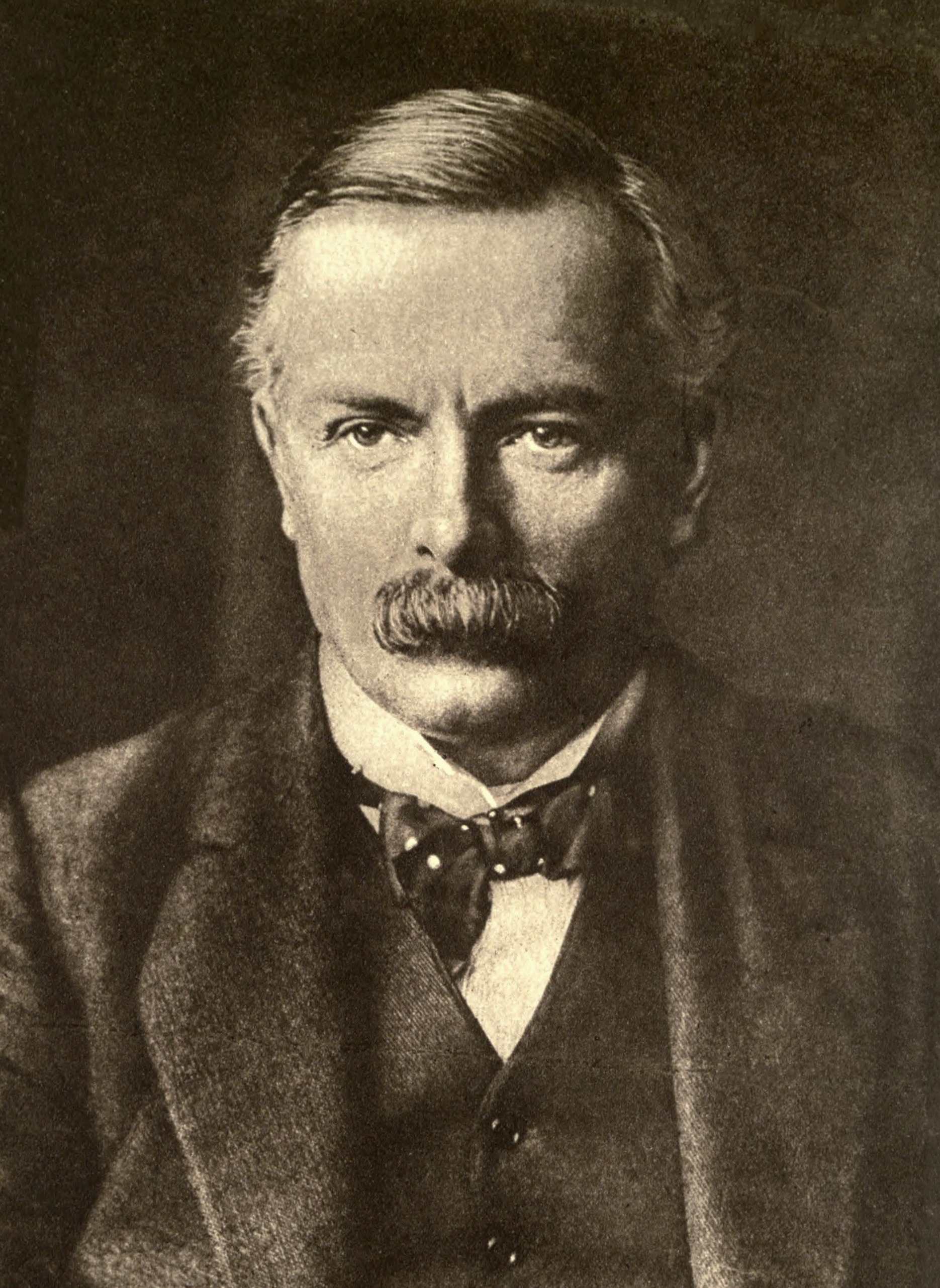|
Metropolitan Railway C Class
The Metropolitan Railway C class was a group of four 0-4-4T Under the Whyte notation for the classification of steam locomotives, 0-4-4 represents the wheel arrangement of no leading wheels, four powered and coupled driving wheels on two axles, and four trailing wheels on two axles. This type was only used ... steam tank locomotives built in 1891 by Neilson and Company. They were to a design by James Stirling, originally the Q class of the South Eastern Railway, and were fitted with condensing apparatus for working in tunnels. The Neilson works numbers were 4352–5, they were delivered in June 1891 as Metropolitan Railway nos. 67–70. Larger boilers were fitted during 1901–03, with the pressure increased to as compared the of the original boilers. No. 67 was sold in 1917 to the Ministry of Munitions; the others were sold in 1923 to Charles Williams of Morriston. References C 0-4-4T locomotives Neilson locomotives Railway locomotives introduced in 1891 ... [...More Info...] [...Related Items...] OR: [Wikipedia] [Google] [Baidu] |
Neilson And Company
Neilson and Company was a locomotive manufacturer in Glasgow, Scotland. The company was started in 1836 at McAlpine Street by Walter Neilson and James Mitchell to manufacture marine and stationary engines. In 1837 the firm moved to Hyde Park Street and was known as Kerr, Mitchell and Neilson and, in 1840, Kerr, Neilson and Company, becoming Neilson and Mitchell in 1843. Locomotive building began in 1843 for the local railways. In 1855 production of marine and stationary engines discontinued and the company changed its name again to Neilson and Company. Among those who later became notable in the field were Henry Dübs and Patrick Stirling. By 1861, business had increased to such an extent, that a new works was built at Springburn, also named "Hyde Park Works." In 1864, Henry Dübs set up in business on his own at Queens Park Works, as Dübs and Company, taking a number of key staff with him. James Reid, who had previously worked for Neilson, however, returned and became ... [...More Info...] [...Related Items...] OR: [Wikipedia] [Google] [Baidu] |
0-4-4T
Under the Whyte notation for the classification of steam locomotives, 0-4-4 represents the wheel arrangement of no leading wheels, four powered and coupled driving wheels on two axles, and four trailing wheels on two axles. This type was only used for tank locomotives. In American cities, the type known as a ''Forney locomotive'', was used on the narrow curves of elevated railways and other rapid transit lines. In the UK 0-4-4 tanks were mainly used for suburban or rural passenger duties. Equivalent classifications Other equivalent classifications are: *UIC classification: B2 (also known as German classification and Italian classification) *French classification: 022 * Turkish classification: 24 * Swiss classification: 2/4 * Russian classification: 0-2-2 History Finland The Finnish Steam Locomotive Class F1 entered service with SVR in 1885 were used until 1935. One example is preserved at the Finnish Railway Museum. United Kingdom In the UK the earliest 0-4-4's were w ... [...More Info...] [...Related Items...] OR: [Wikipedia] [Google] [Baidu] |
Metropolitan Railway
The Metropolitan Railway (also known as the Met) was a passenger and goods railway that served London from 1863 to 1933, its main line heading north-west from the capital's financial heart in the City to what were to become the Middlesex suburbs. Its first line connected the main-line railway termini at , , and King's Cross to the City. The first section was built beneath the New Road using cut-and-cover between Paddington and King's Cross and in tunnel and cuttings beside Farringdon Road from King's Cross to near Smithfield, near the City. It opened to the public on 10 January 1863 with gas-lit wooden carriages hauled by steam locomotives, the world's first passenger-carrying designated underground railway. The line was soon extended from both ends, and northwards via a branch from Baker Street. Southern branches, directly served, reached Hammersmith in 1864, Richmond in 1877 and the original completed the '' Inner Circle'' in 1884. The most important route was north ... [...More Info...] [...Related Items...] OR: [Wikipedia] [Google] [Baidu] |
Tank Locomotive
A tank locomotive or tank engine is a steam locomotive that carries its water in one or more on-board water tanks, instead of a more traditional tender. Most tank engines also have bunkers (or fuel tanks) to hold fuel; in a tender-tank locomotive a tender holds some or all of the fuel, and may hold some water also. There are several different types of tank locomotive, distinguished by the position and style of the water tanks and fuel bunkers. The most common type has tanks mounted either side of the boiler. This type originated about 1840 and quickly became popular for industrial tasks, and later for shunting and shorter-distance main line duties. Tank locomotives have advantages and disadvantages compared to traditional locomotives that required a separate tender to carry needed water and fuel. History Origins The first tank locomotive was the ''Novelty'' that ran at the Rainhill Trials in 1829. It was an example of a ''Well Tank''. However, the more common for ... [...More Info...] [...Related Items...] OR: [Wikipedia] [Google] [Baidu] |
James Stirling (1835–1917)
James Stirling (1835–1917) was a Scottish mechanical engineer. He was Locomotive Superintendent of the Glasgow and South Western Railway and later the South Eastern Railway. Stirling was born on 2 October 1835, a son of Robert Stirling, rector of Galston, East Ayrshire. Career Glasgow and South Western Railway After working for a village millwright he joined the Glasgow and South Western Railway (GSWR) where he was apprenticed to his brother Patrick, who had been Locomotive Superintendent of that railway since 1853. On completion of his apprenticeship, he spent a year as a fitter at Sharp Stewart in Manchester, before returning to the GSWR drawing office at Kilmarnock; he later became works manager. On 1 March 1866, his brother Patrick left the GSWR for the Great Northern Railway (GNR), where he became Works Manager at Doncaster, and James was appointed Locomotive Superintendent of the GSWR in his place. Patrick became the Locomotive Superintendent of the GNR from 1 Oc ... [...More Info...] [...Related Items...] OR: [Wikipedia] [Google] [Baidu] |
SER Q Class
The SER Q class was a class of 0-4-4T steam locomotives of the South Eastern Railway. The class was designed by James Stirling and introduced in 1881. Construction Prior to the appointment of James Stirling as Locomotive Superintendent of the South Eastern Railway (SER) in 1878, that railway possessed only a small number of tank locomotives suitable for the London suburban passenger services. There were twelve 0-4-2WT of the 205 class (later G class) dating from 1863–64; seven 0-4-4WT of the 235 class (later J class) dating from 1866; six 0-4-2WT of the 73 class (later H class) dating from 1867–69; and nine 0-4-4T of the 58 class (later M class) dating from 1877–78. The SER had opened a connection to the London, Chatham and Dover Railway in June1878 giving access to Blackfriars station, the Widened Lines and thus the Great Northern Railway. Tender locomotives were not suitable for working this route, and nor were many of the existing tank engines which were no ... [...More Info...] [...Related Items...] OR: [Wikipedia] [Google] [Baidu] |
South Eastern Railway (UK)
The South Eastern Railway (SER) was a railway company in south-eastern England from 1836 until 1922. The company was formed to construct a route from London to Dover. Branch lines were later opened to Tunbridge Wells, Hastings, Canterbury and other places in Kent. The SER absorbed or leased other railways, some older than itself, including the London and Greenwich Railway and the Canterbury and Whitstable Railway. Most of the company's routes were in Kent, eastern Sussex and the London suburbs, with a long cross-country route from in Surrey to Reading, Berkshire. Much of the company's early history saw attempts at expansion and feuding with its neighbours; the London Brighton and South Coast Railway (LBSCR) in the west and the London, Chatham and Dover Railway (LCDR) to the north-east. However, in 1899 the SER agreed with the LCDR to share operation of the two railways, work them as a single system (marketed as the South Eastern and Chatham Railway) and pool receipts ... [...More Info...] [...Related Items...] OR: [Wikipedia] [Google] [Baidu] |
Condensing Steam Locomotive
A condensing steam locomotive is a type of locomotive designed to recover exhaust steam, either in order to improve range between taking on boiler water, or to reduce emission of steam inside enclosed spaces. The apparatus takes the exhaust steam that would normally be used to produce a draft for the firebox, and routes it through a heat exchanger, into the boiler water tanks. Installations vary depending on the purpose, design and the type of locomotive to which it is fitted. It differs from the usual closed cycle condensing steam engine, in that the function of the condenser is primarily either to recover water, or to avoid excessive emissions to the atmosphere, rather than maintaining a vacuum to improve both efficiency and power. Thermodynamics Unlike the surface condenser often used on a steam turbine or marine steam engine, the condensing apparatus on a steam locomotive does not normally increase the power output, rather it decreases due to a reduction of airflow to t ... [...More Info...] [...Related Items...] OR: [Wikipedia] [Google] [Baidu] |
Ministry Of Munitions
The Minister of Munitions was a British government position created during the First World War to oversee and co-ordinate the production and distribution of munitions for the war effort. The position was created in response to the Shell Crisis of 1915 when there was much newspaper criticism of the shortage of artillery shells and fear of sabotage. The Ministry was created by the Munitions of War Act 1915 passed on 2 July 1915 to safeguard the supply of artillery munitions. Under the very vigorous leadership of Liberal party politician David Lloyd George, the Ministry in its first year set up a system that dealt with labour disputes and fully mobilized Britain's capacity for a massive increase in the production of munitions. The government policy, according to historian J. A. R. Marriott, was that: : No private interest was to be permitted to obstruct the service, or imperil the safety, of the State. Trade Union regulations must be suspended; employers' profits must be limited ... [...More Info...] [...Related Items...] OR: [Wikipedia] [Google] [Baidu] |
Morriston
Morriston (; cy, Treforys ) is a community in the City and County of Swansea, Wales and falls within the Morriston ward. It is the largest community in Swansea county. Morriston is sometimes referred to as a distinct town (e.g. the local football club is named Morriston Town A.F.C.), however it has never had a town charter, and is now part of the continuous urban sprawl around Swansea, the centre of which lies three miles to the south-west. It is the most populous of Swansea's electoral divisions and is situated close to other communities including Plasmarl, Treboeth, Llansamlet, Cwmrhydyceirw, Clase, Ynystawe and Ynysforgan. Landscape and geography Morriston is in the Lower Swansea Valley, adjoining the River Tawe, on terrain sloping gently downwards to the east and steeply upwards to the west. It is centred on Woodfield Street, a shopping area that runs in a north–south axis. The street features two of Morriston's most notable structures, the Church of St John a ... [...More Info...] [...Related Items...] OR: [Wikipedia] [Google] [Baidu] |
Metropolitan Railway Locomotives
Metropolitan may refer to: * Metropolitan area, a region consisting of a densely populated urban core and its less-populated surrounding territories * Metropolitan borough, a form of local government district in England * Metropolitan county, a type of county-level administrative division of England Businesses * Metro-Cammell, previously the Metropolitan Cammell Carriage and Wagon Company * Metropolitan-Vickers, a British heavy electrical engineering company * Metropolitan Stores, a Canadian former department store chain * Metropolitan Books, an imprint of Henry Holt and Company Colleges and universities * Leeds Metropolitan University, United Kingdom * London Metropolitan University, United Kingdom * Manchester Metropolitan University, United Kingdom * Metropolitan Community College (Omaha), United States * Metropolitan State University of Denver, United States ** Metro State Roadrunners * Metropolitan State University, in Saint Paul, Minnesota * Oslo Metropolitan University, Nor ... [...More Info...] [...Related Items...] OR: [Wikipedia] [Google] [Baidu] |






